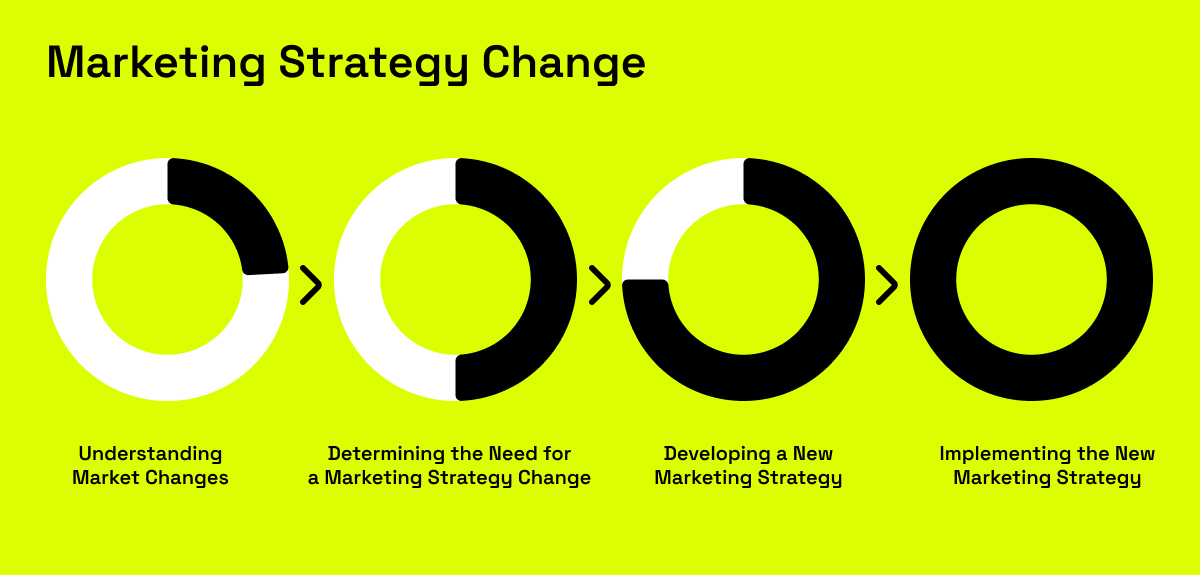
Marketing strategies are crucial for any business looking to succeed in today's competitive marketplace. However, with constant changes in consumer behavior, technology, and industry trends, it's essential for companies to adapt and evolve their marketing approaches to remain relevant and competitive.
As a business owner, you've probably spent countless hours trying to figure out how to get more customers, increase sales and revenue, and increase your brand's visibility, or tried some other tactic to reach more people while keeping costs down.
As a business owner, you've probably spent countless hours trying to figure out how to get more customers, increase sales and revenue, and increase your brand's visibility, or tried some other tactic to reach more people while keeping costs down.

In this article, we'll examine the need for a marketing strategy change and provide a step-by-step guide to help you successfully navigate market shifts and keep your business ahead.
Understanding Market Changes

To effectively adapt to market changes, it's essential to understand the shifts that are occurring. Consumer behavior and preferences are constantly evolving, and staying ahead of these trends is critical to your marketing success. A recent survey by Accenture found that 87% of consumers have changed their shopping habits due to the COVID-19 pandemic, highlighting the need for businesses to be agile in their marketing strategies.
Competition and industry trends are also key factors to consider when evaluating market changes. Keeping an eye on what your competitors are doing, and what's working for them, can provide valuable insights into what changes you may need to make to your marketing strategy. For example, if your competitors have adopted new technology and are seeing success, it may be worth considering implementing similar technology in your marketing approach.
Finally, the impact of new technologies on the market is another important consideration. The rise of social media and mobile devices has changed the way consumers interact with brands, and companies must be aware of these changes to remain competitive. A study by Hubspot found that social media marketing is one of the most effective tactics for lead generation, with 92% of marketers reporting that social media is important for their business.
Determining the Need for a Marketing Strategy Change

Once you have a clear understanding of market changes, the next step is to determine if your current marketing strategy is still effective. To do this, assess its performance and consider areas for improvement. For example, if you're not seeing the desired results from your current marketing campaigns, or if you're not reaching your target audience effectively, it may be time to consider a change.
Another factor to consider is your business goals and target audience. If your target audience has changed, your marketing strategy may need to adapt to better reach and engage them. For example, if you're targeting a younger demographic, you may need to shift your focus to social media marketing and mobile-friendly campaigns.
Developing a New Marketing Strategy

If you've determined that a marketing strategy change is necessary, the next step is to develop a new strategy. Start by setting clear objectives and goals for your marketing campaigns. For example, if you're looking to increase brand awareness, set a goal to increase your social media following by a specific percentage.
Conducting market research and analysis is also critical in developing a new marketing strategy. This will help you better understand your target audience, their needs, and what marketing channels and tactics will be most effective in reaching them.
Define your target audience and buyer personas to ensure your marketing campaigns are tailored to their needs and interests. This will help you create more personalized and effective campaigns that resonate with your audience.
When selecting the right marketing channels and tactics, consider both the costs and potential returns. Social media marketing, email marketing, and content marketing are just a few examples of cost-effective tactics that can drive significant results.
Finally, build a budget and timeline for implementation, ensuring that you have the resources and manpower necessary to execute your new marketing strategy effectively.
Implementing the New Marketing Strategy

Implementing a new marketing strategy is the crucial step that brings your plans to life. Start by training your employees and aligning their efforts to support the new strategy. Make sure everyone understands their roles and responsibilities and is equipped with the knowledge and tools they need to succeed.
Launch new campaigns and promotions to reach your target audience and achieve your marketing goals. Regularly measure and analyze performance metrics, such as website traffic, engagement rates, and conversion rates, to see how your strategy is performing and identify areas for improvement.
It's important to continually refine and adjust your marketing strategy as needed, based on the results you're seeing. This may involve changing your approach, tactics, or even your overall strategy, if you're not seeing the results you desire.
Business Models and Marketing Strategies for Forex or Trading Projects
Forex and trading projects face unique challenges in terms of marketing and business models. It's essential to approach these challenges with a tailored marketing strategy that leverages the unique aspects of the forex and trading industries.

One of the key business models for forex and trading projects is affiliate marketing. By partnering with affiliates and introducing brokers, companies can leverage their networks and reach a broader audience, increasing the potential for new clients and customers. Incentives such as commissions and bonuses can be offered to affiliates as a way to incentivize them to promote the company's services.
Another common business model in the forex and trading industry is the use of online trading platforms and trading signals. These tools allow clients to trade currencies and other assets online, using advanced algorithms and trading signals to make informed decisions. By providing a platform for clients to trade and manage their investments, forex and trading companies can offer a comprehensive solution that caters to their clients' needs.
When it comes to marketing strategies for forex and trading projects, education and awareness building are key. Providing valuable educational resources, such as trading guides, webinars, and market analysis can help build trust and credibility with potential clients. By demonstrating expertise and a deep understanding of the forex and trading industries, companies can establish themselves as reliable and trustworthy providers of forex and trading services.
Social media marketing is another important strategy for forex and trading projects. Platforms such as Twitter, LinkedIn, and Facebook can be leveraged to reach a wider audience and engage with potential clients. By sharing market updates, educational resources, and insights into the forex and trading industries, companies can position themselves as thought leaders and trusted sources of information.
Content marketing, such as blog posts, videos, and infographics, is also an effective way to reach potential clients and build trust and credibility. By providing valuable, relevant, and actionable content, companies can engage with their target audience, demonstrate their expertise, and ultimately drive leads and conversions.
By implementing these strategies effectively and continually monitoring and refining their approach, companies can position themselves as leaders in the forex and trading industries and achieve their marketing goals.
Conclusion
At the end of the day, nothing is more important than keeping your business ahead. Whether you're a small startup or a large company, the ability to adapt to changes in the market is critical for success.
The key to successfully navigating market shifts and keeping your business ahead is to be agile, data-driven, and customer-focused in your marketing approach. By continually monitoring and adjusting your strategy, you can ensure that you remain competitive and relevant in today's fast-paced marketplace.
The key to successfully navigating market shifts and keeping your business ahead is to be agile, data-driven, and customer-focused in your marketing approach. By continually monitoring and adjusting your strategy, you can ensure that you remain competitive and relevant in today's fast-paced marketplace.